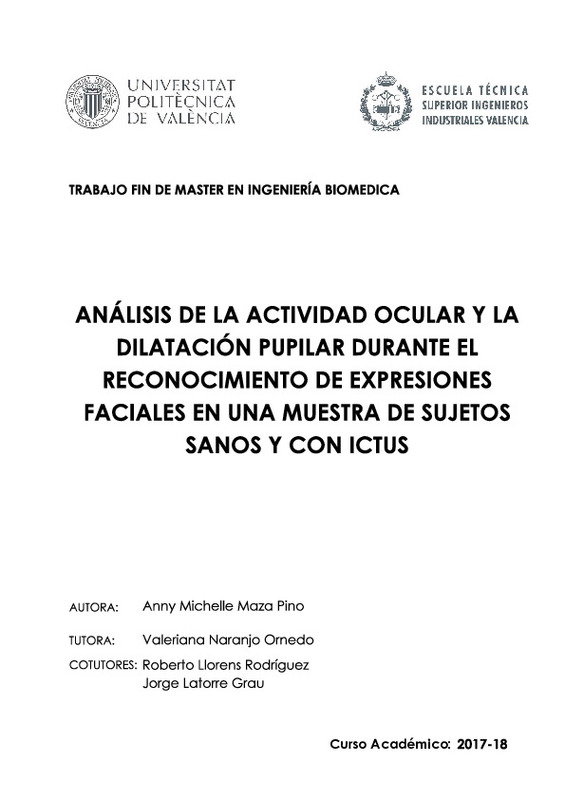JavaScript is disabled for your browser. Some features of this site may not work without it.
Buscar en RiuNet
Listar
Mi cuenta
Estadísticas
Ayuda RiuNet
Admin. UPV
Análisis de la actividad ocular y la dilatación pupilar durante el reconocimiento de expresiones faciales en una muestra de sujetos sanos y con ictus
Mostrar el registro sencillo del ítem
Ficheros en el ítem
| dc.contributor.advisor | Naranjo Ornedo, Valeriana
|
es_ES |
| dc.contributor.advisor | Llorens Rodríguez, Roberto
|
es_ES |
| dc.contributor.advisor | Latorre Grau, Jorge
|
es_ES |
| dc.contributor.author | Maza Pino, Anny Michelle
|
es_ES |
| dc.date.accessioned | 2018-10-08T18:45:58Z | |
| dc.date.available | 2018-10-08T18:45:58Z | |
| dc.date.created | 2018-09-25 | |
| dc.date.issued | 2018-10-08 | es_ES |
| dc.identifier.uri | http://hdl.handle.net/10251/109962 | |
| dc.description.abstract | [ES] Los seres humanos poseemos una capacidad innata de detectar y analizar información facial. A nivel evolutivo, esta capacidad ha permitido, por una parte, identificar unívocamente a congéneres y, por otra parte, detectar su estado emocional. Esta última capacidad posibilita determinar los efectos de las acciones externas (incluidas las causadas por uno mismo) sobre los otros, y adelantarse a reacciones ajenas, lo cual permite planificar las acciones a tomar con antelación. Si bien el sustrato neural de los procesos de detección de estados emocionales está lejos de ser clarificado, existe cierta evidencia de los efectos que una lesión cerebral puede tener en ellos. Así pues, algunos individuos que han sufrido una lesión cerebral causada por un ictus pueden presentar dificultades en detectar expresiones, lo cual dificulta su integración social y laboral. Sin embargo, la evaluación de estas secuelas es raramente estudiada en la clínica y las herramientas para hacerlo son escasas. La tecnología de eye-tracking o seguimiento visual, la cual permite conocer la información que el individuo está visualizando en el tiempo, y la dilatación pupilar se han postulado como medidas fisiológicas que se ve modulada por el procesamiento de estímulos con valencia afectiva. El objetivo del presente Trabajo Fin de Master es el análisis de la respuesta ocular y la dilatación pupilar durante la detección de expresiones faciales en sujetos con ictus en comparación con individuos sanos. | es_ES |
| dc.description.abstract | [EN] Human beings possess an innate ability to detect and analyze facial information. At the evolutionary level, this capacity has allowed, on the one hand, to uniquely identify congeners and, on the other hand, to detect their emotional state. This last capacity makes it possible to determine the effects of external actions (including those caused by oneself) on others, and to anticipate reactions from others, which allows planning the actions to be taken in advance. Although the neural substrate of the processes of detection of emotional states is far from being clarified, there is some evidence of the effects that a brain injury can have on them. Thus, some individuals who have suffered a brain injury caused by a stroke may have difficulties in detecting expressions, which hinders their social and occupational integration. However, the evaluation of these sequelae is rarely studied in the clinic and the tools to do so are scarce. The technology of eye-tracking or visual tracking, which allows knowing the information that the individual is visualizing over time, and pupillary dilation have been postulated as physiological measures that is modulated by the processing of stimuli with affective valence. The objective of the present Master's Thesis is the analysis of ocular response and pupillary dilation during the detection of facial expressions in subjects with stroke in comparison with healthy individuals. | es_ES |
| dc.language | Español | es_ES |
| dc.publisher | Universitat Politècnica de València | es_ES |
| dc.rights | Reserva de todos los derechos | es_ES |
| dc.subject | Expresiones faciales | es_ES |
| dc.subject | Seguimiento visual | es_ES |
| dc.subject | Variabilidad cardíaca | es_ES |
| dc.subject | Daño cerebral adquirido. | es_ES |
| dc.subject.classification | TEORIA DE LA SEÑAL Y COMUNICACIONES | es_ES |
| dc.subject.classification | EXPRESION GRAFICA EN LA INGENIERIA | es_ES |
| dc.subject.other | Máster Universitario en Ingeniería Biomédica-Màster Universitari en Enginyeria Biomèdica | es_ES |
| dc.title | Análisis de la actividad ocular y la dilatación pupilar durante el reconocimiento de expresiones faciales en una muestra de sujetos sanos y con ictus | es_ES |
| dc.type | Tesis de máster | es_ES |
| dc.rights.accessRights | Abierto | es_ES |
| dc.contributor.affiliation | Universitat Politècnica de València. Departamento de Comunicaciones - Departament de Comunicacions | es_ES |
| dc.contributor.affiliation | Universitat Politècnica de València. Escuela Técnica Superior de Ingenieros Industriales - Escola Tècnica Superior d'Enginyers Industrials | es_ES |
| dc.description.bibliographicCitation | Maza Pino, AM. (2018). Análisis de la actividad ocular y la dilatación pupilar durante el reconocimiento de expresiones faciales en una muestra de sujetos sanos y con ictus. http://hdl.handle.net/10251/109962 | es_ES |
| dc.description.accrualMethod | TFGM | es_ES |
| dc.relation.pasarela | TFGM\85903 | es_ES |
Este ítem aparece en la(s) siguiente(s) colección(ones)
-
ETSII - Trabajos académicos [9940]
Escuela Técnica Superior de Ingenieros Industriales






